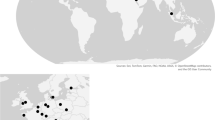Abstract
Several methods used in the published literature for determining the deliquescence relative humidity (DRH) of salts and the mutual deliquescence relative humidity (MDRH) of salt mixtures were reviewed. Experiments were conducted to evaluate an electrical conductivity method for determining the DRH of salts and the MDRH of salt mixtures. The electrical impedance of a conductivity cell containing Na2SO4, CaCl2 and NaCl+NaNO3+KNO3 was measured as a function of relative humidity at temperatures up to 70 ∘C. To provide a basis for interpreting the results of the impedance measurements, computer modeling of the specific electrical conductivity of single salts and salt mixtures at 25 ∘C also was performed. The results of the study demonstrated that the electrical conductivity method provides a convenient and accurate method for determining the DRH of single salts and the MDRH of salt mixtures. The derived DRH and MDRH values were in good agreement with those determined using a hygrometer method. The conductivity method, however, is a more reliable technique than the hygrometer method for determining the MDRH of salt mixtures because the conductivity method is insensitive to slight deviations of mixture composition from the eutonic value.
Similar content being viewed by others
References
L. Greenspan, Humidity Fixed Points of Binary Saturated Aqueous Solutions, J. Res. Nat. Bur. Standards A 81, 89–96 (1977).
Z. Ge, A. S. Wexler, and M. V. Johnston, Multicomponent Aerosol Crystallization, J. Coll. Interf. Sci. 183, 68–77 (1996).
L. Yang, R. T. Pabalan, L. Browning, and D. S. Dunn, Corrosion Behavior of Carbon Steel and Stainless Steel Materials under Salt Deposits in Simulated Dry Repository Environments, in Scientific Basis for Nuclear Waste Management XXVII, R. J. Finch and D. B. Bullen, Eds. Mater. Res. Soc. Symp. Proc. 757, 791–797 (2003).
L. Craig, S. Carroll, and T. Wolery, Deliquescence of NaCl-NaNO3 and KNO3-NaNO3 Salt Mixtures at 90 ∘C, in Water-Rock Interaction, R. Wanty and R. Seal II, Eds. (Taylor & Francis, London, 2004), pp. 1275–1278 .
R. T. Pabalan, L. Yang, and L. Browning, Deliquescence Behavior of Multicomponent Salts: Effects on the Drip Shield and Waste Package Chemical Environment of the Proposed Nuclear Waste Repository at Yucca Mountain, Nevada, in Scientific Basis for Nuclear Waste Management XXV, P. McGrail and G. A. Cragnolino, Eds. Mater. Res. Soc. Symp. Proc. 713, 37–44 (2002).
M. T. Thakker, C. W. Chi, R. E. Peck, and D. T. Wasan, Vapor Pressure Measurements of Hygroscopic Salts, J. Chem. Eng. Data 13, 553–558 (1968).
P. Winkler and C. E. Junge, The Growth of Atmospheric Aerosol Particles as a Function of the Relative Humidity. Part I: Method and Measurement at Different Locations, J. Rech. Atmos. 6, 617–638 (1972).
M. D. Cohen, R. C. Flagan, and J. H. Seinfeld, Studies of Concentrated Electrolyte Solutions using the Electrodynamic Balance. 1. Water Activities for Single-electrolyte Solutions, J. Phys. Chem. 91, 4563–4574 (1987).
I. N. Tang and H. R. Munkelwitz, Composition and Temperature Dependence of the Deliquescence Properties of Hygroscopic Aerosols, Atmos. Environ. A 27, 467–473 (1993).
J. M. Lightstone, T. B. Onasch, D. Imre, and S. Oatis, Deliquescence, Efflorescence, and Water Activity in Ammonium Nitrate and Mixed Ammonium Nitrate/Succinic Acid Microparticles, J. Phys. Chem. A 104, 9337–9436 (2000).
I. N. Tang, H. R. Munkelwitz, and J. G. Davis, Aerosol Growth Studies—IV. Phase Transformation of Mixed Salt Aerosols in a Moist Atmosphere, J. Aerosol Sci. 9, 505–511 (1978).
J.-H. Han and S. T. Martin, Heterogeneous Nucleation of the Efflorescence of (NH4)2SO4 Particles Internally Mixed with Al2O3, TiO2, and ZrO2, J. Geophys. Res. 104, 3543–3553 (1999).
Z. Ge, A. S. Wexler, and M. V. Johnston, Deliquescence Behavior of Multicomponent Aerosols, J. Phys. Chem. A 102, 173–180 (1998).
L. Yang, R. T. Pabalan, and L. Browning, Experimental Determination of the Deliquescence Relative Humidity and Conductivity of Multicomponent Salt Mixtures, in Scientific Basis for Nuclear Waste Management XXV, P. McGrail and G. A. Cragnolino, Eds. Mater. Res. Soc. Symp. Proc. 713, 135–142 (2002).
L. Yang, M. R. Juckett, and R. T. Pabalan, Conductivity Behavior of Salt Deposits on the Surface of Engineered Barrier Materials for the Potential High-level Nuclear Waste Repository at Yucca Mountain, Nevada, in Scientific Basis for Nuclear Waste Management XXVIII, J. M. Hanchar, S. Stroes-Gascoyne, and L. Browning, Eds. Mater. Res. Soc. Symp. Proc. 824, 19–26 (2004).
A. Anderko and M. M. Lencka, Computation of Electrical Conductivity of Multicomponent Aqueous Systems in Wide Concentration and Temperature Ranges. Ind. Eng. Chem. Res. 36, 1932–1943 (1997).
W. F. Linke, Solubilities: Inorganic and Metal-Organic Compounds, 4th ed. (Washington, DC, American Chemical Society, 1965).
V. M. Valyashko and A. A. Ivanov, Maxima of the Electrical Conductivity Isotherms in Water-electrolyte Systems. Russian J. Inorg. Chem. 24, 1528–1533 (1979).
S. G. Chatterjee, B. V. Ramarao, and C. Tien, Water-vapor Sorption Equilibria of a Bleached-kraft Paperboard—A Study of the Hysteresis Region, J. Pulp Pap. Sci. 23, J366–J373 (1997).
S. T. Martin, Phase Transitions of Aqueous Atmospheric Particles, Chem. Rev. 100, 3403–3453 (2000).
R. Vogt and B. J. Finlayson-Pitts, A Diffuse Reflectance Infrared Fourier Transform Spectroscopic Study of the Surface Reaction of NaCl with Gaseous NO2 and HNO3, J. Phys. Chem. 98, 3747–3755 (1994).
Author information
Authors and Affiliations
Rights and permissions
About this article
Cite this article
Yang, L., Pabalan, R.T. & Juckett, M.R. Deliquescence Relative Humidity Measurements Using an Electrical Conductivity Method. J Solution Chem 35, 583–604 (2006). https://doi.org/10.1007/s10953-005-9015-8
Received:
Accepted:
Published:
Issue Date:
DOI: https://doi.org/10.1007/s10953-005-9015-8




